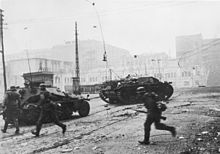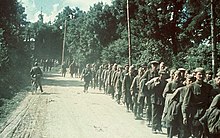Battle of Kharkov (1941)
1941: Białystok-Minsk - Dubno-Lutsk-Rivne - Smolensk - Uman - Kiev - Odessa - Leningrad blockade - Vyazma-Bryansk - Kharkov - Rostov - Moscow - Tula
1942: Rzhev - Kharkiv - Company Blue - companies Braunschweig - company Edelweiss - Stalingrad - Operation Mars
1943: Voronezh-Kharkov - Operation Iskra - North Caucasus - Kharkov - Citadel Company - Oryol - Donets-Mius - Donbass - Belgorod-Kharkov - Smolensk - Dnepr
1944: Dnepr-Carpathians - Leningrad-Novgorod - Crimea - Vyborg-Petrozavodsk - Operation Bagration - Lviv-Sandomierz - Jassy-Kishinew - Belgrade - Petsamo-Kirkenes - Baltic States - Carpathians - Hungary
1945: Courland - Vistula-Oder - East Prussia - West Carpathians - Lower Silesia - East Pomerania - Lake Balaton - Upper Silesia - Vienna - Oder - Berlin - Prague
The First Battle of Kharkov from October 20 to 24, 1941, marks the fighting during the conquest of the eastern Ukrainian city of Kharkov (now Kharkov) during World War II in the Soviet Union . The attack on the city was led by the German 6th Army of Army Group South , while the 38th Army defended it as part of the Soviet southern front .
course
On October 6th the attack of the German 6th Army under General von Reichenau began via Sumy and Ochtyrka in the direction of Belgorod and Kharkov, on the same day the offensive of the 17th Army from the Poltava area in the direction of Losovaya and Isjum to the Donets river followed . The threatened urban area of Kharkov fell within the defense area of the Soviet 38th Army under Lieutenant General Zyganov . During the German advance to the end of the fighting for the city, the Soviet authorities succeeded in dismantling a large part of the war-relevant factories for relocation to the east or in destroying them permanently.
On October 20, 1941, the German troops had reached the western edge of the city, the LV. Army corps under General of the Infantry Vierow was entrusted with the attack on the city. While the 101st Light Division was still about six kilometers west of Kharkov, the 57th Infantry Division under General Dostler was assigned directly to the southern part of the city. On October 21, the Infantry Regiment 217 managed to take the important bridge over the Udy north of Guki without a fight and to form a bridgehead.
The city itself was defended by the Soviet 216th Rifle Division (Colonel DF Makshanow) and the 57th NKVD Brigade (Colonel MG Sokolow), who had developed their positions on the west and northeast parts of the city and also in the Grigorovka forest were focused. After the 101st light division under Lieutenant General Brauner von Haydringen advanced in the northern part of Kharkov and the 100th light division (General Sanne ) had taken the suburb of Nowo Bavaria on the right, the 57th division managed to get through until October 24th fight the eastern part of the city. The advancing 239th Infantry Division cleared the city. At the same time the XVII. Army Corps (General Kienitz ) of the 6th Army advanced further east and built a bridgehead on the Donets at Stary Saltow on October 29 .
literature
- Peter Chen: First Battle of Kharkov . In: World War II Database . 2004-2007. Retrieved February 8, 2007.
- Glantz, David M. (2001). Before Stalingrad , Tempus Publishing Ltd. ISBN 0-7524-2692-3 .
- Kharkiv News
- Kiessling, Hannes (2007–2011). Report of the capture of Kharkov , 57th Infantry Division . Retrieved August 14, 2011.
- Kirchubel, Robert (2003). Operation Barbarossa 1941: Army Group South , Praeger Publishers. ISBN 0-275-98282-3 .
- Margry, Karel (February 2001). "Kharkov", After The Battle , Issue 112, p. 3-45.
- Memoir of Kharkiv's History
- Ukrainian Historical Journal

